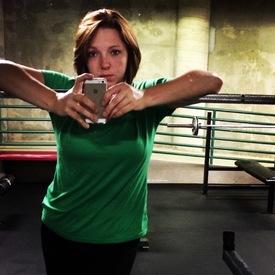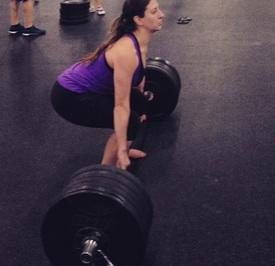Has this happened to you?

xjgirl94
Posts: 64 Member
So since I started eating right and walking and going for a run I have noticed my lower legs have a bad sting in them and it feels like my bones are about to break... Has this happened to anyone else? Am I over doing it? Even though it hurts I still continue to do it, maybe I am over reacting? Who knows
0
Replies
-
I also have bunions and flat feet as well0
-
Where in your lower legs? Your shins, by any chance?
Are you wearing the right shoes for what you're doing? That makes a world of difference.0 -
This is called shin splints. I would not ignore it. Make sure you stretch out properly before running and are wearing the right shoes with adequate support.0
-
Sounds like shin splints to me. I have a few suggestions:
1. Take a break from running/walking and let them heal
2. Apply ice for 20 minutes several times a day to reduce inflammation
3. Check out goodformrunning.com for suggestions on how to improve your form (this is one of the main causes for shin splints)
4. When you resume running/walking.....slow down. You're probably going too fast.
5. Get fitted for shoes. The right shoes will make all the difference in your performance. Every foot is different and since you have issues with flat feet anyway, properly fitted shoes are important. Go to a running specialty store (not a sporting goods store) and have them fit you for shoes. Expect to pay $75-$125 for a good pair of shoes. It's expensive, but they will last you for about 500 miles or so.0 -
is it the front of your legs? I had this once, in English it is called tibialis anterior tendonitis and I think the only thing that helps is rest
 0
0 -
Im not running very fast lol it may be more like a jog but it only hurts when I jog it doesn't hurt during the day or anything and the shoes I wear are zigzags there really comfy and fit my feet pretty good might be the best shoes I ever bought. I don't run everyday or for long periods I balance it out by running for about a minute then walking for a minute and so on0
-
Shin splints go away as you become acclimated to the exercise.0
-
Its more towards the ankles where I feel it but I am going to look up shin splints to read about it
0 -
Nope, hasn't happened to me. (Knock on wood!!) But, I'm only on week two of my little c25k thing. A couple days, when I got up, I had the typical stiff, achy feeling you get when you work new muscles (or seriously demand a lot of ones you normally use a lot.) But that's it. So far (knock on wood again.)
If you have pain, you should consult a doctor.
0 -
cure for shin splints is toe raises.0
-
Liftng4Lis wrote: »Shin splints go away as you become acclimated to the exercise.
I'm going to disagree with you there. Bad form can perpetuate the problem. A friend of mine is an experienced runner. She is completely acclimated to running. And yet she got shin splints while training for a half (her 5th, I think?). The cause was bad form - due to undiagnosed scoliosis, which is a whole other issue, but it affected her running form.
Having good form and continuing to practice good form is a key part in preventing injury.
And zig-zags may be comfortable. I'm not saying they aren't. But I can tell you that properly fitted shoes help prevent injury. It's something to consider.
0 -
Liftng4Lis wrote: »Shin splints go away as you become acclimated to the exercise.
I'm going to disagree with you there. Bad form can perpetuate the problem. A friend of mine is an experienced runner. She is completely acclimated to running. And yet she got shin splints while training for a half (her 5th, I think?). The cause was bad form - due to undiagnosed scoliosis, which is a whole other issues, but it affected her running form.
Having good form and continuing to practice good form is a key part in preventing injury.
And zig-zags may be comfortable. I'm not saying they aren't. But I can tell you that properly fitted shoes help prevent injury. It's something to consider.
In that case, THANK GOD mine went away after a week! laughs0 -
Liftng4Lis wrote: »Shin splints go away as you become acclimated to the exercise.
I'm going to disagree with you there. Bad form can perpetuate the problem. A friend of mine is an experienced runner. She is completely acclimated to running. And yet she got shin splints while training for a half (her 5th, I think?). The cause was bad form - due to undiagnosed scoliosis, which is a whole other issue, but it affected her running form.
Having good form and continuing to practice good form is a key part in preventing injury.
And zig-zags may be comfortable. I'm not saying they aren't. But I can tell you that properly fitted shoes help prevent injury. It's something to consider.
What are the best kind of shoes? Im new to the whole running thing but I love it besides this it makes me feel good
0 -
missbishop1015 wrote: »Liftng4Lis wrote: »Shin splints go away as you become acclimated to the exercise.
I'm going to disagree with you there. Bad form can perpetuate the problem. A friend of mine is an experienced runner. She is completely acclimated to running. And yet she got shin splints while training for a half (her 5th, I think?). The cause was bad form - due to undiagnosed scoliosis, which is a whole other issue, but it affected her running form.
Having good form and continuing to practice good form is a key part in preventing injury.
And zig-zags may be comfortable. I'm not saying they aren't. But I can tell you that properly fitted shoes help prevent injury. It's something to consider.
What are the best kind of shoes? Im new to the whole running thing but I love it besides this it makes me feel good
I can't give you the advice on what shoes are best. The shoes that work for me probably aren't the shoes that will work for you.
The best way to find out is to get fitted at a running specialty store.
0 -
Stretch before & after workouts
Look at investing in some new good running trainers - Go to your local sports shops. There are so many different types of trainers. Get some advice, and test for comfort.
Good luck!0 -
missbishop1015 wrote: »So since I started eating right and walking and going for a run I have noticed my lower legs have a bad sting in them and it feels like my bones are about to break... Has this happened to anyone else? Am I over doing it? Even though it hurts I still continue to do it, maybe I am over reacting? Who knows
Okay, avid runner here, for years in fact. I've never had that feeling before. That would freak me out.
There is a difference between muscle aches and actual hurting- please do not run if it hurts to run, especially in the manner that you describe above.
First off, you need to go to the doctor and have this checked out to make sure there is no underlying medical condition.
Secondly, if all is cleared by your doc to run, make sure you get fitted for good running shoes.
Thirdly, make sure you stretch well before and after running.
ETA: I see you said you are running slow. Just take care of yourself.
0 -
This is called shin splints. I would not ignore it. Make sure you stretch out properly before running and are wearing the right shoes with adequate support.
That doesn't sound like shin splints to me. I've had them before and, even though they are painful, what she describes doesn't sound like them.0 -
Could be a variety of things. Easiest diagnosis would be shinsplints (see below), followed by tendinitis (rest), then stress fracture (doctor).
1) The running shoes pick the runner. Have you been fitted by a bonafide running store? Zigzags are NOT running shoes. They are for something else, but definitely not "serious" running. I wouldn't run to the mailbox in them.
2) Are you running at an easy, conversational pace?
3) What is your cadence like? Should be turning over 180-190 times per min.
4) Stride length? Are you crashing on your heels? Try transitioning to forefoot striking. It will naturally increase your cadence and decrease the impact time while adjusting your center of gravity and allowing you to have a springier bounce forward to your next step.
0 -
SonicDeathMonkey80 wrote: »Could be a variety of things. Easiest diagnosis would be shinsplints (see below), followed by tendinitis (rest), then stress fracture (doctor).
1) The running shoes pick the runner. Have you been fitted by a bonafide running store? Zigzags are NOT running shoes. They are for something else, but definitely not "serious" running. I wouldn't run to the mailbox in them.
2) Are you running at an easy, conversational pace?
3) What is your cadence like? Should be turning over 180-190 times per min.
4) Stride length? Are you crashing on your heels? Try transitioning to forefoot striking. It will naturally increase your cadence and decrease the impact time while adjusting your center of gravity and allowing you to have a springier bounce forward to your next step.
What does cadence mean?0 -
missbishop1015 wrote: »SonicDeathMonkey80 wrote: »Could be a variety of things. Easiest diagnosis would be shinsplints (see below), followed by tendinitis (rest), then stress fracture (doctor).
1) The running shoes pick the runner. Have you been fitted by a bonafide running store? Zigzags are NOT running shoes. They are for something else, but definitely not "serious" running. I wouldn't run to the mailbox in them.
2) Are you running at an easy, conversational pace?
3) What is your cadence like? Should be turning over 180-190 times per min.
4) Stride length? Are you crashing on your heels? Try transitioning to forefoot striking. It will naturally increase your cadence and decrease the impact time while adjusting your center of gravity and allowing you to have a springier bounce forward to your next step.
What does cadence mean?
How many steps you take per minute. The 180-190 is both feet. 190 is a little high, but the sweet spot is in the 180s. It's a little more work at first, but once your muscles get used to it, your joints and shins will thank you.
0 -
SonicDeathMonkey80 wrote: »missbishop1015 wrote: »SonicDeathMonkey80 wrote: »Could be a variety of things. Easiest diagnosis would be shinsplints (see below), followed by tendinitis (rest), then stress fracture (doctor).
1) The running shoes pick the runner. Have you been fitted by a bonafide running store? Zigzags are NOT running shoes. They are for something else, but definitely not "serious" running. I wouldn't run to the mailbox in them.
2) Are you running at an easy, conversational pace?
3) What is your cadence like? Should be turning over 180-190 times per min.
4) Stride length? Are you crashing on your heels? Try transitioning to forefoot striking. It will naturally increase your cadence and decrease the impact time while adjusting your center of gravity and allowing you to have a springier bounce forward to your next step.
What does cadence mean?
How many steps you take per minute. The 180-190 is both feet. 190 is a little high, but the sweet spot is in the 180s. It's a little more work at first, but once your muscles get used to it, your joints and shins will thank you.
I really aint too sure, like for instance if I ran a mile half of it I walk and half of it I run. I run around a big square pretty much so I walk from one stop sign to the next then run till I get to the next stop sign then walk and so on and I do a mile in a little over 14 minutes0 -
You should stop running if you have any kind of pain while doing it. Over-use injuries are common when beginning a running regimen and they can snowball into big problems if you ignore them. For the time being, try to switch to a low impact cardio work out while you figure out what's going on.
You still didn't really specifically describe your pain - is it the front or back of your 'ankles'? If it's the back near your heel then it could be your Achilles tendon. If it's the front then shin splints or compartment syndrome are more likely. Any of that requires rest and time to heal before beginning again. Slow and steady wins the race when running.
Also, if you plan on continuing to use running/jogging as your main cardio exercise you definitely need to get a pair of dedicated running shoes that you only use for running. Get fitted at a running store and keep track of how many miles you put on them. Your current shoes might be comfortable to you but if they are the culprit of your pains then it's not worth it. If you go to a running store they will give you advice on what shoes to get.0 -
Before everyone jumps to shin splints...
Where exactly is the pain? Is it on the inside or the outside of your leg.
This started happening to me a few months ago on the outside of my right leg, from the ankle to just above the calf. It feels like needles are stabbing me now when I run. I can't even make it 400m before it starts.
I thought it was shin splints, but it's compartment syndrome. I hoped that with rest it would go away, but it hasn't. The only way to fix it is with surgery. Sucks.0 -
missbishop1015 wrote: »SonicDeathMonkey80 wrote: »missbishop1015 wrote: »SonicDeathMonkey80 wrote: »Could be a variety of things. Easiest diagnosis would be shinsplints (see below), followed by tendinitis (rest), then stress fracture (doctor).
1) The running shoes pick the runner. Have you been fitted by a bonafide running store? Zigzags are NOT running shoes. They are for something else, but definitely not "serious" running. I wouldn't run to the mailbox in them.
2) Are you running at an easy, conversational pace?
3) What is your cadence like? Should be turning over 180-190 times per min.
4) Stride length? Are you crashing on your heels? Try transitioning to forefoot striking. It will naturally increase your cadence and decrease the impact time while adjusting your center of gravity and allowing you to have a springier bounce forward to your next step.
What does cadence mean?
How many steps you take per minute. The 180-190 is both feet. 190 is a little high, but the sweet spot is in the 180s. It's a little more work at first, but once your muscles get used to it, your joints and shins will thank you.
I really aint too sure, like for instance if I ran a mile half of it I walk and half of it I run. I run around a big square pretty much so I walk from one stop sign to the next then run till I get to the next stop sign then walk and so on and I do a mile in a little over 14 minutes
Cadence doesn't have anything to do with how fast or slow you're running. It's about how many steps you take per minute. Basically, what's going to happen is that your feet are going to fall closer together (your stride is shorter). Your steps will be small instead of big.
To get an idea, try listening to songs that have 180 beats per minute, and have a foot land on every beat. This will get you used to the cadence you should be running at (regardless of how fast or slow you go).
Here's a website with a list of songs:
http://running.about.com/od/musicforrunning/a/Running-Songs-At-180-Bpm.htm0
This discussion has been closed.
Categories
- All Categories
- 1.4M Health, Wellness and Goals
- 398.2K Introduce Yourself
- 44.7K Getting Started
- 261K Health and Weight Loss
- 176.4K Food and Nutrition
- 47.7K Recipes
- 233K Fitness and Exercise
- 462 Sleep, Mindfulness and Overall Wellness
- 6.5K Goal: Maintaining Weight
- 8.7K Goal: Gaining Weight and Body Building
- 153.5K Motivation and Support
- 8.4K Challenges
- 1.4K Debate Club
- 96.5K Chit-Chat
- 2.6K Fun and Games
- 4.8K MyFitnessPal Information
- 12 News and Announcements
- 21 MyFitnessPal Academy
- 1.5K Feature Suggestions and Ideas
- 3.2K MyFitnessPal Tech Support Questions











